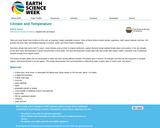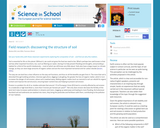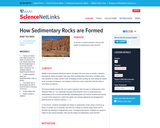
This parent guide supports parents in helping their child at home with the 6th grade Science content.
- Subject:
- Science
- Material Type:
- Reference Material
- Vocabulary
- Author:
- Kelly Rawlston
- Letoria Lewis
- Date Added:
- 10/11/2022

This parent guide supports parents in helping their child at home with the 6th grade Science content.

This resource accompanies our Rethink 6th Grade Science course. It includes ideas for use, ways to support exceptional children, ways to extend learning, digital resources and tools, tips for supporting English Language Learners and students with visual and hearing impairments. There are also ideas for offline learning.

In this lesson, students determine the particle size and composition of a sample of soil. Soil composition determines many characteristics of soils, such as infiltration rates (the rate at which water moves into a soil), percolation rates (how fast water moves through the soil), settling rates (how fast sediments sink to the bottom of a body of water), oxygen content, and the ability of the soil to support plant and animal life.

In this lesson, students understand how water moves through different types of soils.

In this lesson, students explain how and why the settling rates of particles varies with particle size.

This resource website provides background content information and resources that are helpful to teachers when planning instruction about minerals, rocks, and the rock cycle.

In this lesson, students learn about soil profiles and how they can change in depth or nutrient composition based on changes in vegetation and even animal activity through discussion and viewing a clip from "The Lion King."

Students will investigate how climate affects soil and its formation. The inquiry activity will demonstrate how soil temperature is affected by water content, plant or mulch cover, and aspect.

Students demonstrate the difference in soil textures and how this difference relates to soil density. DIfferences in the proportion of soil components are what determine soil texture, which also affect soil properties. Students will also understand other factors such as compaction that affect soil density.

In this two-part lesson, students learn about soil structure and its organic matter content. In the first activity, students carry out a simple experiment to collect soil samples and test their stability to learn which types of soil are liekly to be more prone to erosion. In the second activity, students find out about the mineral composition of soil samples.

Students will investigate variations in the soils around their school to discover that soil properties like moisture, temperature, color, and texture exhibit considerable variability across a single landscape.

In this lesson the students will become actively engaged by being a rock in the rock cycle. They will travel to different places and experience the different processes and events that can happen to a rock in the rock cycle. This lesson was developed by Richard Kidd as part of their completion of the North Carolina Global Educator Digital Badge program. This lesson plan has been vetted at the local and state level for standards alignment, Global Education focus, and content accuracy.

The students will use a simulated rock and perform various tasks to see what actually happens to rocks and rock fragments as they undergo the transformations within the rock cycle. This lesson was developed by Richard Kidd as part of their completion of the North Carolina Global Educator Digital Badge program. This lesson plan has been vetted at the local and state level for standards alignment, Global Education focus, and content accuracy.

The students will use a simulated rock and perform various tasks to see what actually happens to rocks and rock fragments as they undergo the transformations within the rock cycle. This lesson was developed by Richard Kidd as part of their completion of the North Carolina Global Educator Digital Badge program. This lesson plan has been vetted at the local and state level for standards alignment, Global Education focus, and content accuracy.

In this lesson students will learn about the various processes involved in breaking down rocks both physically and chemically. They will also compare a process they do in class to what happens to rocks and other land forms in the real world. This lesson was developed by Richard Kidd as part of their completion of the North Carolina Global Educator Digital Badge program. This lesson plan has been vetted at the local and state level for standards alignment, Global Education focus, and content accuracy.

Students will make comparisons to facilitate understanding about the similarities and differences between soil properties on Earth and Mars.

Students review the basic rock cycle and then focus specifically on sedimentary rock. Students investigate the stripes in sedimentary rocks using a structure at Petra, Jordan, and then complete a hands-on activity using mixed nuts to illustrate the layering of sedimentary rocks.

In this lesson, students will investigate the processes of deposition and erosion through a hands-on activity and lab simulating the impact on Earth's surface. Students will also identify unique landforms that are created as a result of erosion and deposition.

In this lab activity, students will investigate particle sorting and deposition. Students will combine gravel, sand, clay, and potting soil in a 2L bottle, add water, shake the contents, and allow the water to evaporate. Once the sediments have settled and dried, students will cut the bottle in half and obseve the cross section. Students will make observations with a small group and record observations in their science journals.

In this activity, students will investigate rocks and then use their descriptive data to match with another student.